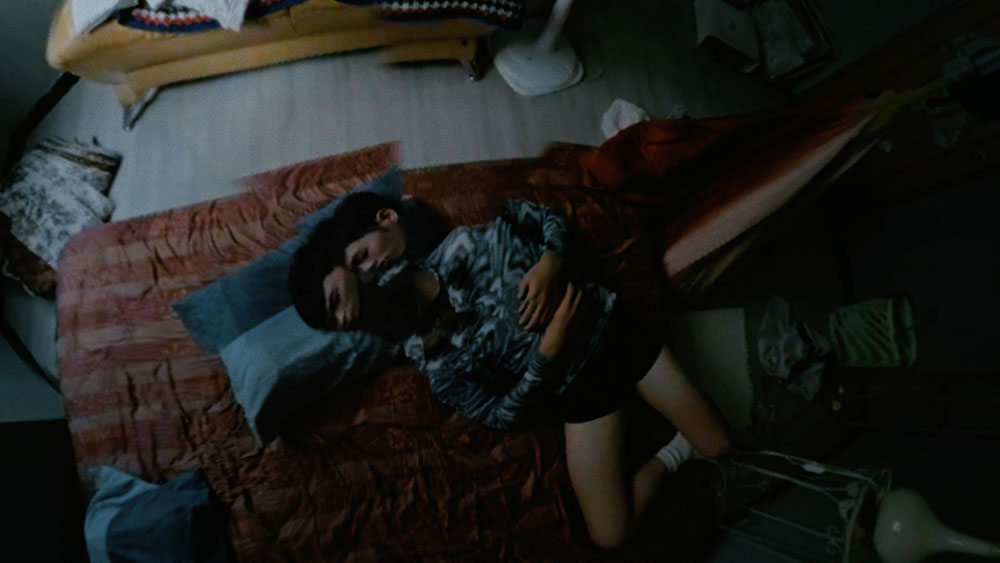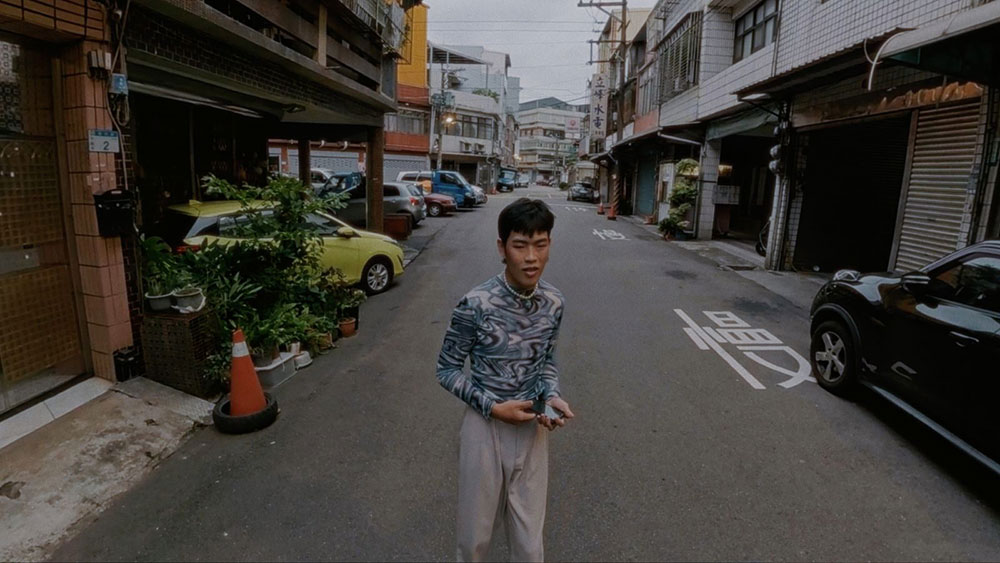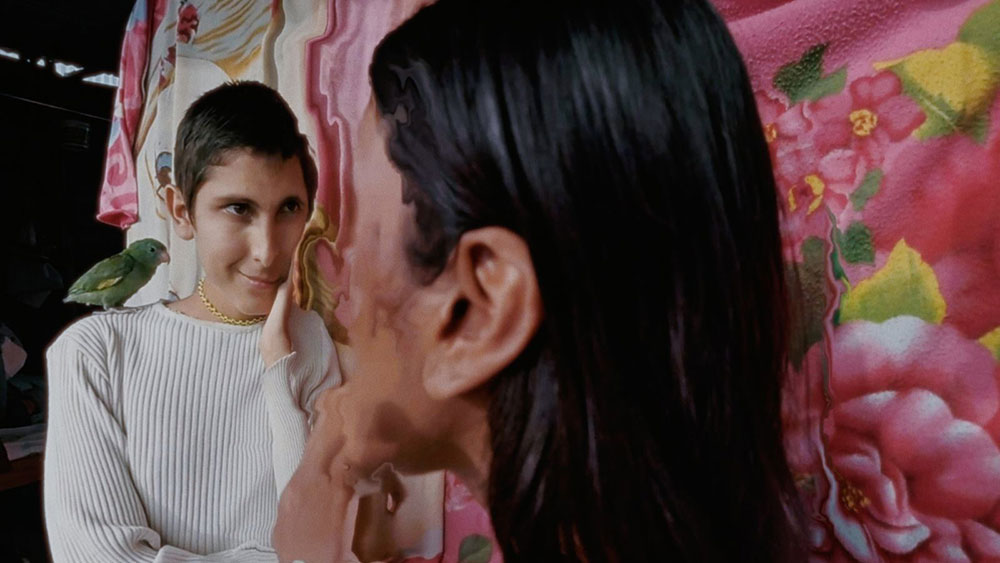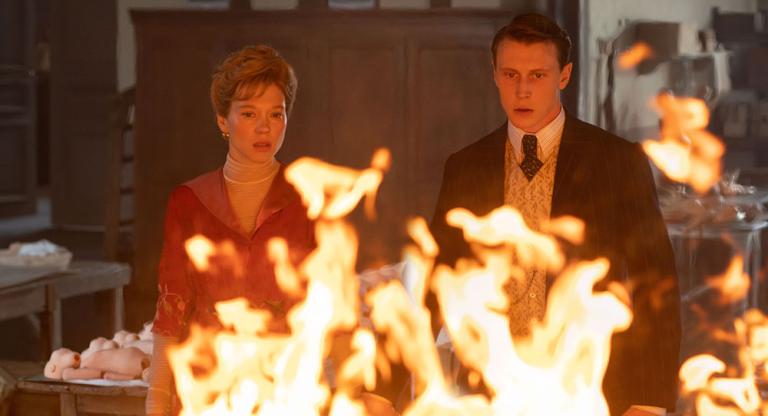Since its premiere in 2016, Eduardo “Teddy” Williams’s The Human Surge has captivated a niche yet zealous following. The premise is simple: people in Mozambique, the Philippines, and the director’s native Argentina go about their lives amid ecological disaster and infrastructural collapse––live-camming for money, wading through floods, searching for wifi. What perhaps so strongly endears viewers to the film is the charm of the characters, whose vivaciousness stands in uncanny contrast to their surroundings. Fantasy realism, evoked from a precise attunement to the polar extremes of modern experience, has been Williams’s signature mood from the start. His first short, Could See a Puma (2011), in which teenagers roam through the stark landscape of a thermal spring in Bueno Aires amid tree overgrowth and industrial shrapnel, renders ode-to-joy innocence within apocalyptic desolation.
Some artworks spin webs of affinity, binding us to peer enthusiasts with their silken threads. This is true of Williams’s films, whose “stickiness” has an additional, visceral register. They emit wetness and flows––the glittering stream of urine that showers a trail of ants in The Human Surge, or the liquid speed of Saigon traffic through a rain-smeared GoPro in his short I Forgot! (2014). For The Human Surge 3, the long-awaited sequel that opens the Currents section of this year’s New York Film Festival, Williams takes the original formula and spins it on its head. New characters––who this time move between Taiwan, Sri Lanka, and Peru––are warped through a 360-degree VR camera, glitched and datamoshed, in weather more dramatic and volatile.
A graduate of Le Fresnoy, Williams is part of an experimental set who approaches new imaging technologies as a way to break open perception and the assumed (human) position of the observer. Unlike some of his contemporaries, his work is less scaffolded by theory than guided by sensate curiosity. Consider his installation A Very Long GIF alongside Véréna Paravel and Lucien Castaing-Taylor’s De Humani Corporis Fabrica––both imaging the inside of the body via the endoscopy pill camera, both released in 2022. Through graphic closeups, De Humani portrays the procedures of Parisian hospitals, reflecting on the history and ethics of medicine writ large. A Very Long GIF presents a meditative journey through the artist’s own internal organs, shots of their bubbling green and brown liquids eventually merging into one of the sea. Watching the inside of his entrails, I pondered, Is this technically a nude? Does this constitute porn? Such is the effect of Williams’s cinema, which constantly throws once-stable concepts into question.
We met at the Teatro di Locarno, the dual casino-theater where press screenings for the Locarno Film Festival were held. There’s something paradoxical about asking Williams to speak on his work, given its elusive, orphic nature. I mentioned this. He laughed coolly. “It’s true, my films are more interesting than anything I could say.”

Minh Nguyen: Your dialogue always sticks with me. Like in Surge 3 when two characters float in their flooded town and one says, “I can’t believe we’re alive and are talking about our old age.” It’s such a strange thing to say for the situation. Are your lines scripted or improvised?
Eduardo Williams: Some of the lines are written by me, some of them are improvised. I keep a travel journal where I also write scripts and lines. Sometimes I take lines from books or the internet. Sometimes during shooting I put a weird line in the script to see what will change, so it’s like improvisation with an intruder in the middle.
There’s a part in Surge 1 when they’re in the cave and someone says “I would love to hear a prehistoric shout” and someone else responds “the dog’s shout is the ancient shout.”
That I think I took from the Argentinian poet Mariano Blatt, whose poem I used in Parsi (2018).
You use non-professional actors, casting in a number of ways––online, flyering, casting calls, WhatsApp groups. What do you look for when you cast?
I like to spend time with people and just feel it out. This was the first time we looked for something very specific, which was for LGBTQ people. I realized that when I didn’t look for that we could create a very heterosexual world. I wanted to share different ways of being LGBTQ in other places. We also wanted to widen the age range, but it was difficult, because I think when you’re young you have more time to be free for projects like this.
It’s funny you say your films feel heterosexual because they feel very gay to me.
To me too, because I make them. But sometimes I’m traveling to places I don’t know, or places where it’s illegal to be gay. It can be a little bit of a hiding act.
Your films have always reminded me of Lionel Soukaz’s, particularly his www.webcam (2006) in which guys perform browser-based sex acts. I also think of the workers cruising each other in the factory days before it shuts down in Alain Guiraudie’s The Old Dream That Moves (2001).
People have mentioned Soukaz’s work to me in relation to mine. When I was growing up I wasn’t in contact with non-classical films or anything alternative. There’s a film I love, João Pedro Rodrigues’s O Fantasma (2000).
But I don’t remember many films, and I don’t see many anymore. When I see a film I don’t like it’s depressing because I just think of what it must be like for people to see my films and not like them. It’s a little heartbreaking. Sometimes when I’m traveling I’m in places where there aren’t many cinemas, and I like to watch things on the computer less and less.
Reminds me of Apichatpong Weerasethakul talking about how he doesn’t watch many films either, how he prefers to be in “3D World.”
Many people make films that are amazing references to the medium, its history, its industry. Mine aren’t like that. They’re more inspired by everything around us.
In the beginning, do you have scenes in mind first? Locations? How does it come together for you?
Usually I have at least two or three places that I already know. In Sri Lanka I saw this neighborhood of spherical houses. I loved how they looked. It’s typical of what I like, both fantastical and common. Something that’s shocking when you see it for the first time but is also mundane for the people who live there. The houses are also shaped like that because there was a tsunami in the area and this shape is tsunami-resistant. It usually starts with a landscape, like the cave that opens in front of a garden in France in That I’m Falling? (2013) Sometimes during editing I’ll think, We need one more scene of the water.
There’s always this contrast of calm and volatility, lightness and darkness, like in Could See a Puma.
That was shot in the Buenos Aires province, far from the city. It was a thermal spring where people used to holiday. They constructed a dam that failed and was flooded in the late ’80s then abandoned like that. It’s a very spectacular place. I wanted to make a film there that showed how people could move through it. I wanted it to feel surprising that the kids weren’t addressing the surroundings. You wonder, is it normal for them? Do they just not see the same things I see? This type of doubt, the questioning whether the characters are seeing the same thing you see––I think about this mechanism a lot.
The lightness and darkness you mention—I try to capture the contradicting mood of how we live now. We are worried about climate change but we also quickly get used to and normalize things. I want to reflect the way these things are layered, of apocalypse that never arrives but is also arriving and already here. Hollywood would show a more dramatic apocalypse, but mine is one that both recedes and is always on the surface.

I definitely got that from the first Surge, that it’s a portrait of living through apocalypse, but not a clichéd story of resilience. The characters are so charming and playful. In the sequel, these characters are more manic. There’s something pitched up about them. They seem a little hysterical.
Really? In what way? I’m intrigued by that.
They just seem pitched up, dialed up. I felt less familiar with them. I relate to the characters in the first Surge, and with the second one not as much. There are more mediations, like glitches and distortions. They are talking more, and it is more discontinuous.
They are talking more, that’s true. It’s funny because at one point I actually wanted to pitch up their voices and even accelerate parts of the film. Relating is subjective though. My idea was for the camera to come in and out of looking at them. To me there is tenderness between the characters, whether the camera or viewer has access to it or not. In the first one there were different types of intimacy, maybe sexual. Here is a different kind of intimacy, maybe more strange, but it’s there.
In Surge 3, the characters also travel to each other rather than remain in their countries, as in the first Surge, which adds a new aspect of migration. Was travel difficult or surprising?
It was complicated for sure. Every time there’s a complication it tests my ideas and I think about how much I want to push them. The main idea of this project from the start was about traveling with people from places where traveling isn’t so common. First we had to figure out getting visas in their countries, which were especially complicated from Sri Lanka to Peru. When they came out of the airport, a guard just decided to not believe in their papers and they were held in the airport. We had to contact the Embassy of Argentina in Brazil, because that’s where they were going, to send a letter so they could get through. Finally they arrived. In Taiwan the visas weren’t complicated but there were Covid factors. Finally, in Locarno, Switzerland didn’t give a visa to one of the Sri Lankan actors, so they couldn’t come, which was bad and showed the hypocrisy of wanting to show people on screen but refusing to host them in their own country.
I wanted to see what would happen for the actors to travel, how possible fluidity would be. I knew it would be easy in some instances and difficult in others. Their migration may not be super direct in the film but it’s definitely a part of it.
During production you were interested in simulating a lightning strike, by sending a copper cable to the clouds, as you had seen in a YouTube video.
Weather is always important for me. I wanted the film to be under the rain the whole time. We rain-proofed all of our equipment, and traveled to Sri Lanka during the rainy season. But weather is less and less possible to predict. With the flood in the first Surge, that was also something I couldn’t prepare. The first day of shooting we were in a bar and saw on TV that there was a flood in Córdoba, so we immediately drove there. In Surge 3, you see a flood in Peru. This is a flood that happens every year, and people plan around it and live in it for months. I imagined this flood as an evolution to the first flood.
I was talking to your sound editor, Paulo Lima, the other day, and he told me that all your films are about the same thing, more or less: they’re all about the fear of dying. Except for Could See a Puma, he said, which is about something completely different.
Really? I love that.
Do you agree?
About the fear of dying? I don’t feel that at all. But I love that everyone interprets in their own ways. I think it’s true that all my films could be about the same things. A friend, another director, told me that when she was watching the end of Surge 1, when the person was looking for internet connection in the Philippines, she thought, Aha, that’s the meaning of life. We’re all searching for connection in the dark. But being afraid of dying, I don’t know. What do you think?
Well . . . I’m kind of convinced they are already dead. I think they’re in an afterlife. They’re serene and kind of ecstatic. They have this blank slate. They don’t quite feel mortal.
Maybe it’s––we have a Spanish word for it, entregada. It’s how I feel sometimes. How can I explain, I don’t have the word in English. When you realize you’re like . . . delivered. Acceptance. When you give yourself to time and space. Accepting yourself as an element. Another phrase I have for this feeling is “Que je tombe tout le temps” which translates to “that I am falling all the time.”
Yes, there’s something delivered about them. They’re in such extreme situations and they have no anxiety.
I think a lot about what rhythm I want my films to have. The rhythm of our lives is one of anxiety and speed and no patience. What I love about cinema is that it is one of the few things that can give us, for however long, a new rhythm. This is what I try to create. In my life everything takes me more into anxiety than out of it, so I want to do the opposite in my films.
The Human Surge 3 screens tonight, September 30, and throughout the New York Film Festival, its U.S. premiere. Tonight and tomorrow’s screenings will be followed by a conversation with director Eduardo Williams.




